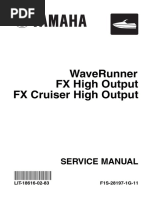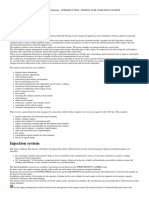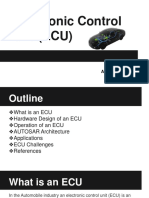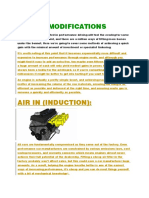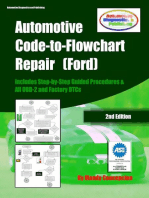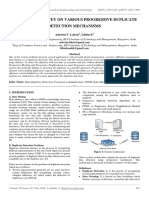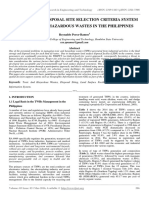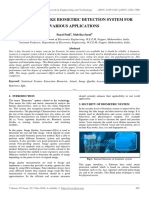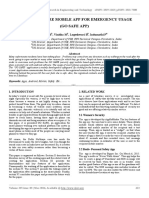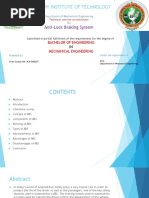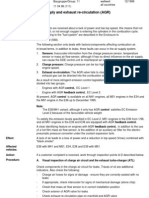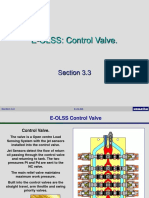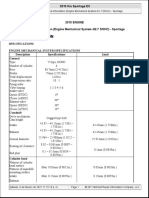Designs of Input and Output Driver Circuits For 16-Bit Electronic Control Unit (Ecu) and Development of Control Strategy For Ecu Using These I o Driver Circuits
Uploaded by
esatjournalsDesigns of Input and Output Driver Circuits For 16-Bit Electronic Control Unit (Ecu) and Development of Control Strategy For Ecu Using These I o Driver Circuits
Uploaded by
esatjournalsIJRET: International Journal of Research in Engineering and Technology
eISSN: 2319-1163 | pISSN: 2321-7308
DESIGNS OF INPUT AND OUTPUT DRIVER CIRCUITS FOR 16-BIT
ELECTRONIC CONTROL UNIT (ECU) AND DEVELOPMENT OF
CONTROL STRATEGY FOR ECU USING THESE I/O DRIVER CIRCUITS
Mansi K. Ajudia1, Mahesh T. Kolte2, Prasanta Sarkar3
1
Department of Electronics & Telecommunication, M.E. 2nd Year (E&TC), M.I.T College of Engineering Pune
2
Department of Electronics & Telecommunication, H.O.D (E&TC), M.I.T College of Engineering Pune
3
TTL Pvt. Ltd., Pune, University of Pune, India
Abstract
The rapid prototype based method for design process of control strategy of electronic control unit for input and output driver circuit
for 16-bit Electronic Control Unit (ECU). This method saves time and cost for making of an electronic control unit board and uses the
electronic control unit board having a type of microcontroller in which we can flash code many times for generation of control
strategy. Based on the given circuit, development of control strategy for electronic control unit is done in microcontrollers supported
IDE. Then, test and verify the developed code with the use of given input and output driver circuits for electronic control unit on test
bench with virtual engine environment setup or in an actual vehicle. The whole process is associated with development of Engine
Management System. In this paper the input and output driver circuit design is given for further development of control code for four
wheeler vehicles. Using this technique the validation process of electronic control unit board is done on test bench setup or in actual
vehicle.
Keywords- Electronic Control Unit, Integrated Development Environment, Engine Management System, Manifold-air
Pressure, Accelerator Pedal Position, Engine Coolant Temperature, Controller Area Network
----------------------------------------------------------------------***----------------------------------------------------------------------1. INTRODUCTION
Electronic Control Unit Consists of input and output drivers
circuits with communication devices as its peripherals. Those are
used for controlling purpose for internal operation of electronic
control unit. The main aim of the peripheral circuits for
electronic control unit is to drive vehicle with greater accuracy
on road condition for achieving better performance from vehicle.
Testing of electronic control unit on bench is required because
vehicles engine contains dangerous liquids and harmful gases so
the vehicle and electronic control unit may get damaged.
So, it necessary to test electronic control unit on test bench
earlier and then set up it to actual vehicle. Therefore, the process
of development of control code is done in the microcontrollers
IDE and tested the same on test bench or in a vehicle.
Fig 1: ECU input output circuit diagram
For above given process the circuit of input and output drivers of
electronic control unit is required. For designing purpose
peripheral circuits of electronic control units is done using circuit
__________________________________________________________________________________________
Volume: 03 Issue: 05 | May-2014, Available @ http://www.ijret.org
102
IJRET: International Journal of Research in Engineering and Technology
CONTROL UNIT
A digital input signal is a type of signal that represents two
voltage levels first is high and second is low. The digital signals
are having two states for representation and transition of data.
The digital input provides the on/off (triggered) type data
input to the ECU for its operation. Typically the on/off switch
input (toggle switches) are given as a reference for digital
inputs of electronic control unit. All digital inputs are
preconfigured with internal pull up resistors which can be
preconfigured or set during the programming of ECU to
convene particular environment. All digital inputs are feed
with 5V supply with respect to Ground. The digital signal is
not having continuously variable value like analog signals. The
two state values of digital inputs have been expressed in various
ways like high/low, on/ off, 0/1.
An analog signal is a type of signal which represents
continuously variable voltage and amplitude with respect to time
is called as an analog signal. The analog inputs refer and
receive the outcome from sensors. In other words an analog
input senses the sensor information and feed them to the ECU
using a supported voltage level of microcontroller. Typical
analog inputs for ECU include accelerator pedal position
sensor signal (APP), manifold-air pressure sensor signal
(MAP), and engine coolant temperature sensor signal
(coolant) etc. are referred as analog inputs. All analog inputs
given here are supplied with 5V with reference to ground
potential (zero/negative potential).
VPWR VDD
16
C9
100nF
U2
31
2. ANALOG INPUT CIRCUIT FOR ELECTRONIC
CONTROL UNIT
SI
SCLK
CS
7
Ignition_Switch_Input(on/of f )
C10
100nF
VDD
An Electronic Control Unit consists of functional blocks:
Microcontroller or microprocessor
Power Supply Section
Analog Inputs (continuously varying values)
Digital Inputs (on/off type inputs)
Frequency Inputs (vehicle speed input)
Digital Outputs (on/off type output)
Injector Driver Output
Ignition Coil Driver Output
3. DIGITAL INPUT CIRCUIT FOR ELECTRONIC
VPWR
tool drafting tool. Here in this paper the schematic for the input
and output driver circuits of 16-bit Electronic Control Unit
design is given using orcade capture tool.
eISSN: 2319-1163 | pISSN: 2321-7308
SO
SP2
AMUX
2
3
4
32
30
uC_124
uC_125
uC_126
uC_123
uC_104
C8
4.7pF
VCC
U1
uC_106
16
C5
100nF
29
GND
INT
14
Engine_Coolant_Temp
Digital_Input
VCC
R1
COM
18K
C4
800pF
B
C
Y5
INH
11
10
9
6
0
uC_84
uC_86
uC_83
R3
Manif oldair_Pressure_Signal
uC_111
18K
C6
4.7pF
4. DIGITAL OUTPUT DRIVER CIRCUIT FOR
ELECTRONIC CONTROL UNIT
Analog_Input
Fig 3: Digital I/P Circuit for 16-bit ECU
uC_85
C3
4.7pF
C1
800pF
GND
Accelerator_Pedal_Position
R2
uC_113
Y1
18K
C2
4.7pF
C7
800pF
The Low-side Switch and Low-side Drive outputs are used to
control the low side of relay coils and other devices. These
outputs current on the low-side (zero potential), they are
constantly attached to the negative potential a zero potential
region of circuit. An example of a Low-side Switch output
enabling an external relay.
Fig 2: Analog I/P Circuit for 16-bit ECU
__________________________________________________________________________________________
Volume: 03 Issue: 05 | May-2014, Available @ http://www.ijret.org
103
IJRET: International Journal of Research in Engineering and Technology
5.
SOPWR VPWR
eISSN: 2319-1163 | pISSN: 2321-7308
FREQUENCY
INPUT
CIRCUIT
FOR
ELECTRONIC CONTROL UNIT
SO
C17
100nF
C13
4.7pF
PWM
Crank_Signal_Input_+v e
42-44
C15
4.7nF
Digital_Output
C14
800nF
R4
1k
R6
2
COUT
VCCVPWR
uC_125
uC_68
uC_123
uC_113
18
32
19
14
DI
S5
0
20
SCLK
CS
DO
IN5
D5
21
Fuel_Pump_Switch
IN6
C20
4.7uF
GND
uC_110
16
VPWR
VDD
0
17
uC_11
Frequency _Input
Fig 6: Frequency I/P Circuit for 16-bit ECU
6. INJECTOR AND IGNITION COIL DRIVER
CIRCUIT FOR ELECTRONIC CONTROL UNIT
VPWR
C18
100nF
31
C19
The low-side driver switch outputs are selected as low voltage
and current range probably the ranges are 2A which indicates
low value, 5A which indicates medium value, or 10A which
indicates high value with respect to their current conducting
capabilities. The only care must be taken to make sure that the
devices related with the ECU, which do not exceed the ratings
of their respective outputs.
IN_BIAS
Fig 4: Digital O/P Circuit for 16-bit ECU
uC_124
IN-
1k
4.7nF
1n
U4
IN+
18K
Crank_Signal_Input_-v e
100nF
U5
R5
GND
uC_109
Main_Relay _Startup_Switch(on/of f )
GND
50
VCC
33
OUT10
35
uC_123
SI
10
uC_124
CS
VCC
32
SCLK
INT_THRS
uC_8
ZERO_EN
23
The Electronic Control unit senses the input signal coming
from variable reluctance sensor (VR); these inputs are being
used to provide trigger sensor information to the ECU. These
is used in many other applications, typically these are uses
include in Cam-shaft/Crank-shaft Position/Vehicle Speed
Sensors and wheel speed sensors.
C12
100nF
20
uC_125
U3
VPWR
SOPWR
C11
100nF
Injectors are driven with the help of output signal, which is
coming from ECU having lower voltage range. Supply of 12
V feed to injectors, which is coming from main power relay of
vehicle. High impedance or low impedance injectors can be
used with engine lab controllers without the need for higher
value resistors. Similarly, Ignition coils are driven with the
help of output signal, which is coming from the ECU and
having lower voltage range. So, many different types of
ignition characteristics are supported, such as MultiSequential, Multi-Wasted Spark, Single, Distributor coil and
many more. In multi-coil package, the spark gap is used
which supports a igniters pack, which are supplied by
the positive 12V main relay signal from the main power relay
of vehicle for driving purpose of vehicle successfully on the
running condition.
Digital_Output
Fig 5: Digital O/P Circuit for 16-bit ECU
__________________________________________________________________________________________
Volume: 03 Issue: 05 | May-2014, Available @ http://www.ijret.org
104
IJRET: International Journal of Research in Engineering and Technology
eISSN: 2319-1163 | pISSN: 2321-7308
VDD
VDD VPWR
U7
uC_10
uC_123
uC_36
uC_40
4
7
10
24
uC_123
CS
GD0
SO
Q1
1
DIN0
RSP
uC_71
C21
4.7nF
IGBT1
26
25
uC_135
2
1
40mOhm
R9
GIN0
V_SUPPLY
C24
100nF
SCLK
MOSI
CANH
18
CAN_High
MISO
INT
CANL
uC_134
27
19
CAN_Low
TXD
RXD
CAN
GND
SPKDUR
Fig 8: Controller Area Network Circuit for 16-bit ECU
8. EXPERIMENT AND RESULTS
Injector_Ignition_Driv e_Circuit
Fig 7: Injector and Ignition Coil Circuit for 16-bit ECU
7.
26
Ignition_Driv er_Output
33
uC_18
R8
36K
RSN
20
uC_124
12
GND
FB0
24
VSUP
CS
6-9,20-23
SCLK
27
Injector_Driv er_Output
4
2
OUT0
uC_125
4
2
0
1
uC_125
SI
uC_22
uC_124
VPWR
C22
100nF
25
U6
VDD
100nF
VDD
C23
C25
100nF
CONTROLLER
AREA
NETWORK
(CAN)
CIRCUIT FOR ELECTRONIC CONTROL UNIT
The Can Bus is used to control and communicate with Can
devices on the vehicle. To control the air pollution and
emission of harmful which are produced by todays
automotive industry, the automotive industry has developed
multiple electronic systems. Those main functions are to
improve pollution and fuel consumption. Those systems
having more complication thats why those required the data
exchange among them, therefore they required so many hardwired connections for performance of dedicated lines for
signal operations. The CAN Communication protocol gives
the complete solution path for its function. With, the help of
CAN, microcontrollers, vehicle sensors and output directed
actuators communicate or interact with each other devices in
the given node network, in real(synchronized)-time, with a
speed of up to 1Mbit/second, over a two wire cable serial
(ongoing) data bus.
Procedure for Generating the Control Algorithm for input and
output driver circuits of 16-bit Electronic Control Unit (ECU) in
the
microcontrollers
given
Integrated
Development
Environment (IDE) using the input and output driver circuit and
pin mapping of input and output driver circuits with using above
given figures for input and output driver circuits.
/**************
read
*************************/
A_HC4851_SetVal();
B_HC4851_ClrVal();
C_HC4851_SetVal();
analog
I/ps
AD1_Measure(1);
//Measure Accelerator pedal signal
AD1_GetValue8(Analog_values);
Acc_Pedal_Signal = Analog_values[2];
A_HC4851_SetVal();
B_HC4851_ClrVal();
C_HC4851_ClrVal();
AD1_Measure(1);
//Measure Engine Coolant temp signal
AD1_GetValue8(Analog_values);
Eng_Coolant_Temp_Signal = Analog_values[2];
u32_vECT_couRaw = Eng_Coolant_Temp_Signal;
MAP_Signal =
pressure signal
Analog_values[0]; //Measure Manifold air
/**************
end
of
read
analog
I/ps*******************/
/************** read digital I/p ******************/
__________________________________________________________________________________________
Volume: 03 Issue: 05 | May-2014, Available @ http://www.ijret.org
105
IJRET: International Journal of Research in Engineering and Technology
read break switch i/p
if(!MC33972_vRead_IP(Rd_Buffer)){
if((Rd_Buffer[0]&0x01)){//if ignition on
eISSN: 2319-1163 | pISSN: 2321-7308
method. With using this method we can develop a code for input
and output driver circuits for ECU.
REFERENCES
// MC33999B_MainRelay_SetVal(); //switch on main relay
MC33999B_MainRelay_ClrVal();
FuelPump_ClrVal();
} else {
// MC33999B_MainRelay_ClrVal(); //switch off main relay
MC33999B_MainRelay_SetVal();
FuelPump_SetVal();
} }
/************** end of read digital I/p ****************/
[1]
[2]
[3]
[4]
[5]
Jian HU, Gangyan LI and Jun XU, Component-Based
ECU Design Method of Passenger Car Information
Integrated Control System, International Conference on
Automation and Logistics, Shenyang, China August 2009.
Daniel D.Gajski, Frank Vahid, Sanjiv Narayan, Jie Gong,
Specification and Design of Embedded Systems,
Prentice Hall PTR, ISBN: 978-0131507319, 1994.
EAST-EEA consortium, EAST-EEA Embedded
Electronic Architecture, Available: www.east-eea.net,
2008.
AUTOSAR development partnership, TECHNICAL
OVERVIEW, Available: www.autosar.org, 2008.
AUTOSAR Layered Software Architecture, R3.0,
Rev.0001, November, 2007.
Fig 9: Results of ECU Variables in INCA Window
In the given figure the results of ECU inputs are shown. This
result shows the variable value in the software tool for ECU
variables and its parameters.
9. CONCLUSIONS
The actual development process of electronic control unit board
takes much time and cost. For solution of these difficulties we
can use such type of microcontroller based ECU board in which
we can use a controller which supports the flash programmable
memory. Therefore, we can easily do flashing of code on
microcontroller of ECU board. This technique is very useful
because we can get many applications as per our desired code.
By, using this method, development process of control code
increases the code flexibility, efficiency, reuse ability and
reliability in case of testing or validation process for Electronic
Control Unit on test bench, on virtual environment PC setup and
in a vehicle.
This process is initial and essential for testing purpose of
automotive electronic circuits on test bed setup. This is the best
example of component based Electronic Control Unit design
__________________________________________________________________________________________
Volume: 03 Issue: 05 | May-2014, Available @ http://www.ijret.org
106
You might also like
- Kawasaki KX125 KX250 Service Manual Repair 1999 2000 2001 2002 99924 1244 0473% (11)Kawasaki KX125 KX250 Service Manual Repair 1999 2000 2001 2002 99924 1244 04260 pages
- SM-Bobcat 630, 631, 632 Skid Steer Loader Service Repair Manual PDF83% (12)SM-Bobcat 630, 631, 632 Skid Steer Loader Service Repair Manual PDF284 pages
- Douglas DC-8 - JT3D Powerplant Study Guide PDF67% (3)Douglas DC-8 - JT3D Powerplant Study Guide PDF30 pages
- Understanding ECU Remapping Audi TT 1 8t Tutorial100% (1)Understanding ECU Remapping Audi TT 1 8t Tutorial62 pages
- Electronic Control Unit (ECU) : Ankul GuptaNo ratings yetElectronic Control Unit (ECU) : Ankul Gupta20 pages
- Electronic Automotive Transmission Troubleshooter Nissan-Infinity VehiclesFrom EverandElectronic Automotive Transmission Troubleshooter Nissan-Infinity VehiclesNo ratings yet
- Thomson Electrac HD Linear Actuator Motion Control per CAN BusFrom EverandThomson Electrac HD Linear Actuator Motion Control per CAN BusNo ratings yet
- Fuel Pump With Brushless Motor For High Vibration Applications100% (2)Fuel Pump With Brushless Motor For High Vibration Applications4 pages
- Professional Electronic Control Unit Diagnosis KTS and DCU:: Innovative Complete SolutionsNo ratings yetProfessional Electronic Control Unit Diagnosis KTS and DCU:: Innovative Complete Solutions24 pages
- User Guide For ALIENTECH Suite and KESS3 OBD100% (1)User Guide For ALIENTECH Suite and KESS3 OBD47 pages
- Led Drive Systems For Automotive ApplicationsNo ratings yetLed Drive Systems For Automotive Applications11 pages
- Electro-Mechanical Power Steering: Design and FunctionNo ratings yetElectro-Mechanical Power Steering: Design and Function34 pages
- Automobile Battery Monitoring System Using Arduino Uno R3 Microcontroller BoardNo ratings yetAutomobile Battery Monitoring System Using Arduino Uno R3 Microcontroller Board14 pages
- Engine Management: Subject: Mechatronics System Design Submitted To: Engr. Zubair Submitted by100% (1)Engine Management: Subject: Mechatronics System Design Submitted To: Engr. Zubair Submitted by6 pages
- Bosch - Catalog Semiconductori Și Senzori 2014No ratings yetBosch - Catalog Semiconductori Și Senzori 201436 pages
- Manual Transmission and Differential (Diagnostics)No ratings yetManual Transmission and Differential (Diagnostics)38 pages
- Engine Modifications: Air in (Induction)No ratings yetEngine Modifications: Air in (Induction)5 pages
- Постер - двигатель h Series Bsiii - Bsiv - Crs - RusNo ratings yetПостер - двигатель h Series Bsiii - Bsiv - Crs - Rus1 page
- KAYO EFI Instructions: 1 Operating PrincipleNo ratings yetKAYO EFI Instructions: 1 Operating Principle16 pages
- Paper - Presentation Hybrid - Vehicle NewNo ratings yetPaper - Presentation Hybrid - Vehicle New10 pages
- 2021 Toyota Corolla Hybrid Quick Reference100% (2)2021 Toyota Corolla Hybrid Quick Reference56 pages
- INA Tec Brochure Valve Train Components en 09 2012100% (1)INA Tec Brochure Valve Train Components en 09 201244 pages
- A Review Paper On Smart Health Care System Using Internet of ThingsNo ratings yetA Review Paper On Smart Health Care System Using Internet of Things5 pages
- Analysis of Cylindrical Shell Structure With Varying Parameters PDFNo ratings yetAnalysis of Cylindrical Shell Structure With Varying Parameters PDF6 pages
- Analysis and Optimization of Electrodes For Improving The Performance of Ring Laser Gyro PDFNo ratings yetAnalysis and Optimization of Electrodes For Improving The Performance of Ring Laser Gyro PDF4 pages
- Analysis and Design of A Multi Compartment Central Cone Cement Storing Silo PDFNo ratings yetAnalysis and Design of A Multi Compartment Central Cone Cement Storing Silo PDF7 pages
- A Research On Significance of Kalman Filter-Approach As Applied in Electrical Power SystemNo ratings yetA Research On Significance of Kalman Filter-Approach As Applied in Electrical Power System8 pages
- A Study and Survey On Various Progressive Duplicate Detection MechanismsNo ratings yetA Study and Survey On Various Progressive Duplicate Detection Mechanisms3 pages
- A Servey On Wireless Mesh Networking ModuleNo ratings yetA Servey On Wireless Mesh Networking Module5 pages
- A Survey On Identification of Ranking Fraud For Mobile ApplicationsNo ratings yetA Survey On Identification of Ranking Fraud For Mobile Applications6 pages
- A Review Paper On Smart Health Care System Using Internet of ThingsNo ratings yetA Review Paper On Smart Health Care System Using Internet of Things5 pages
- Pushover Analysis-To Study Seismic Performances of Vertical Irregular Structure PDFNo ratings yetPushover Analysis-To Study Seismic Performances of Vertical Irregular Structure PDF4 pages
- A Servey On Wireless Mesh Networking ModuleNo ratings yetA Servey On Wireless Mesh Networking Module5 pages
- A Three-Level Disposal Site Selection Criteria System For Toxic and Hazardous Wastes in The PhilippinesNo ratings yetA Three-Level Disposal Site Selection Criteria System For Toxic and Hazardous Wastes in The Philippines9 pages
- Power Generation Using Maglev Windmill PDFNo ratings yetPower Generation Using Maglev Windmill PDF6 pages
- A Review On Fake Biometric Detection System For Various ApplicationsNo ratings yetA Review On Fake Biometric Detection System For Various Applications4 pages
- A Study and Survey On Various Progressive Duplicate Detection MechanismsNo ratings yetA Study and Survey On Various Progressive Duplicate Detection Mechanisms3 pages
- A Research On Significance of Kalman Filter-Approach As Applied in Electrical Power SystemNo ratings yetA Research On Significance of Kalman Filter-Approach As Applied in Electrical Power System8 pages
- A Women Secure Mobile App For Emergency Usage (Go Safe App)No ratings yetA Women Secure Mobile App For Emergency Usage (Go Safe App)3 pages
- Privacy Preserving Through Mediator in Decentralized Ciphertext Policy Attribute Based Encryption PDFNo ratings yetPrivacy Preserving Through Mediator in Decentralized Ciphertext Policy Attribute Based Encryption PDF6 pages
- Structure and Operation: 3. Electronic Control Unit Connection Diagram100% (2)Structure and Operation: 3. Electronic Control Unit Connection Diagram24 pages
- 2.4L GM Industrial Eng Service Manual LP & ByfuelNo ratings yet2.4L GM Industrial Eng Service Manual LP & Byfuel132 pages
- Perator'S Anual: Automatic Lawn Tractor Models 607 608 609No ratings yetPerator'S Anual: Automatic Lawn Tractor Models 607 608 60944 pages
- TM 9-705 Scout Cars, M3, M3A1, and 4.2 Mortar Motor Carriage, M2 1941100% (1)TM 9-705 Scout Cars, M3, M3A1, and 4.2 Mortar Motor Carriage, M2 1941220 pages
- ZenkiS14,13-ECUPinoutSR20DET-colors DecodedNo ratings yetZenkiS14,13-ECUPinoutSR20DET-colors Decoded1 page
- Egt and Combustion Analysis: in A NutshellNo ratings yetEgt and Combustion Analysis: in A Nutshell14 pages
- Kawasaki KX125 KX250 Service Manual Repair 1999 2000 2001 2002 99924 1244 04Kawasaki KX125 KX250 Service Manual Repair 1999 2000 2001 2002 99924 1244 04
- SM-Bobcat 630, 631, 632 Skid Steer Loader Service Repair Manual PDFSM-Bobcat 630, 631, 632 Skid Steer Loader Service Repair Manual PDF
- Data Acquisition from HD Vehicles Using J1939 CAN BusFrom EverandData Acquisition from HD Vehicles Using J1939 CAN Bus
- Electronic Automotive Transmission Troubleshooter Nissan-Infinity VehiclesFrom EverandElectronic Automotive Transmission Troubleshooter Nissan-Infinity Vehicles
- Thomson Electrac HD Linear Actuator Motion Control per CAN BusFrom EverandThomson Electrac HD Linear Actuator Motion Control per CAN Bus
- Automotive Electronic Diagnostics (Course 2)From EverandAutomotive Electronic Diagnostics (Course 2)
- Fuel Pump With Brushless Motor For High Vibration ApplicationsFuel Pump With Brushless Motor For High Vibration Applications
- Professional Electronic Control Unit Diagnosis KTS and DCU:: Innovative Complete SolutionsProfessional Electronic Control Unit Diagnosis KTS and DCU:: Innovative Complete Solutions
- Electro-Mechanical Power Steering: Design and FunctionElectro-Mechanical Power Steering: Design and Function
- Automobile Battery Monitoring System Using Arduino Uno R3 Microcontroller BoardAutomobile Battery Monitoring System Using Arduino Uno R3 Microcontroller Board
- Engine Management: Subject: Mechatronics System Design Submitted To: Engr. Zubair Submitted byEngine Management: Subject: Mechatronics System Design Submitted To: Engr. Zubair Submitted by
- Manual Transmission and Differential (Diagnostics)Manual Transmission and Differential (Diagnostics)
- Постер - двигатель h Series Bsiii - Bsiv - Crs - RusПостер - двигатель h Series Bsiii - Bsiv - Crs - Rus
- INA Tec Brochure Valve Train Components en 09 2012INA Tec Brochure Valve Train Components en 09 2012
- Automotive Variable Valve Timing & Lift ExplainedFrom EverandAutomotive Variable Valve Timing & Lift Explained
- A Review Paper On Smart Health Care System Using Internet of ThingsA Review Paper On Smart Health Care System Using Internet of Things
- Analysis of Cylindrical Shell Structure With Varying Parameters PDFAnalysis of Cylindrical Shell Structure With Varying Parameters PDF
- Analysis and Optimization of Electrodes For Improving The Performance of Ring Laser Gyro PDFAnalysis and Optimization of Electrodes For Improving The Performance of Ring Laser Gyro PDF
- Analysis and Design of A Multi Compartment Central Cone Cement Storing Silo PDFAnalysis and Design of A Multi Compartment Central Cone Cement Storing Silo PDF
- A Research On Significance of Kalman Filter-Approach As Applied in Electrical Power SystemA Research On Significance of Kalman Filter-Approach As Applied in Electrical Power System
- A Study and Survey On Various Progressive Duplicate Detection MechanismsA Study and Survey On Various Progressive Duplicate Detection Mechanisms
- A Survey On Identification of Ranking Fraud For Mobile ApplicationsA Survey On Identification of Ranking Fraud For Mobile Applications
- A Review Paper On Smart Health Care System Using Internet of ThingsA Review Paper On Smart Health Care System Using Internet of Things
- Pushover Analysis-To Study Seismic Performances of Vertical Irregular Structure PDFPushover Analysis-To Study Seismic Performances of Vertical Irregular Structure PDF
- A Three-Level Disposal Site Selection Criteria System For Toxic and Hazardous Wastes in The PhilippinesA Three-Level Disposal Site Selection Criteria System For Toxic and Hazardous Wastes in The Philippines
- A Review On Fake Biometric Detection System For Various ApplicationsA Review On Fake Biometric Detection System For Various Applications
- A Study and Survey On Various Progressive Duplicate Detection MechanismsA Study and Survey On Various Progressive Duplicate Detection Mechanisms
- A Research On Significance of Kalman Filter-Approach As Applied in Electrical Power SystemA Research On Significance of Kalman Filter-Approach As Applied in Electrical Power System
- A Women Secure Mobile App For Emergency Usage (Go Safe App)A Women Secure Mobile App For Emergency Usage (Go Safe App)
- Privacy Preserving Through Mediator in Decentralized Ciphertext Policy Attribute Based Encryption PDFPrivacy Preserving Through Mediator in Decentralized Ciphertext Policy Attribute Based Encryption PDF
- Structure and Operation: 3. Electronic Control Unit Connection DiagramStructure and Operation: 3. Electronic Control Unit Connection Diagram
- Perator'S Anual: Automatic Lawn Tractor Models 607 608 609Perator'S Anual: Automatic Lawn Tractor Models 607 608 609
- TM 9-705 Scout Cars, M3, M3A1, and 4.2 Mortar Motor Carriage, M2 1941TM 9-705 Scout Cars, M3, M3A1, and 4.2 Mortar Motor Carriage, M2 1941

